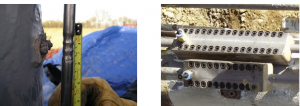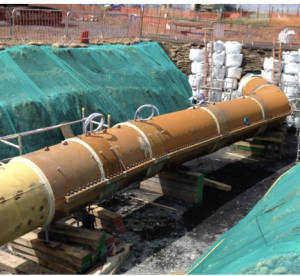October 2016, Vol. 243, No. 10
Features
Cost-Efficient Pipeline Fixes with Zero Downtime

Live pipeline repair and intervention can reduce risk, help maintain product supply and limit economic liabilities that could occur when removing or replacing pipeline sections. Disruption to product delivery can have huge consequences if a pipeline operator has a contractual obligation to keep gas or liquids flowing. Decommissioning a pipeline may cost a plant or operator millions of dollars per day in lost revenue.
Qualifying live repair options on a damaged pipeline requires profound understanding of the challenges involved, such as the type of damage, current pipe geometries, operating conditions and environment, material aspects, pipeline product, safety operations and the interactions between all of these factors.
DNV GL has invested in research and development (R&D) to make the operational expenditure of pipeline repair as efficient as possible and has developed a number of practical repair procedures and a range of live repair solutions. A key factor of success has been the evolution of epoxy technology. The company has used the technology to provide solutions to an array of complex problems faced by oil and gas operators worldwide.
In the early 1980s, British Gas developed a pipeline repair technology to replace the conventional repair method of welding a close-fitting repair sleeve onto a pipeline. The epoxy sleeve can be used on pipeline defects such as corrosion, dents, gouges, cracking, minor leaks or a combination of these. Even today, it remains one of the only pipeline repair methods suitable for girth-weld defects. Figure 1 illustrates the general layout of a welded-type epoxy sleeve and the key components of an epoxy sleeve repair.
Figure 1: Component diagram of a welded-type epoxy repair sleeve.
The epoxy sleeve repair supports (Figure 2) and strengthens damaged pipelines without interrupting the product flow. Each fitting consists of two oversized half-shells, which are either welded or mechanically joined to fully encircle the damaged section of pipeline. The annulus is then sealed at both ends prior to being injecting with epoxy grout. This results in a repair that is usually stronger than the undamaged portion of the pipe material. On completion of a repair, the shell can be linked to the pipeline for cathodic protection.
Figure 2: Welded and flanged epoxy repair sleeves installed by DNV GL.
Adaptability
Epoxy technology is versatile. It has several key advantages compared to alternative technologies including:
- Elimination of all welding works on site during installation
- Significant reduction of installation time on site
- Reduction of operational delays
- Probability of improving scheduled installation
- Independence from parent pipe materials
- Adaptability to an array of projects and manipulated to many different uses
- Infinite length of pipeline can be covered in a road crossing
- Large variety of diameter sizes can be covered with an installation
Due to the characteristics the technology possesses it has been modified and developed to provide solutions for numerous applications.
Epoxy Sleeve Repair
The epoxy repair sleeve has been designed for small-diameter applications typical of valve body vent and sealant line corrosion (Figure 3). Sealant line repair sleeves have been qualified for pressures of 689 barg (10,000 psig) in order to accommodate sealant injection pressure.
Figure 3: Epoxy repair sleeve, small-diameter application.
Domed Repair
The epoxy sleeve repair also has been adapted to completely encapsulate damaged or corroded fittings by means of a domed repair (Figure 4). The design is based on the principles and concepts of the traditional epoxy repair sleeve, whereby the fitting is split into half shells – the branch half shell and the lower half shell.
The branch half shell has a welded dome end that is placed over the damaged fitting and bolted, along the longitudinal flanges, to the lower half shell. The remaining gap is then flooded with epoxy grout, providing a permanent repair to the pipework.
Figure 4: Domed epoxy repair sleeve.
Epoxy End Seals
Prior to the introduction of thick wall pipe for road crossings, thousands of steel sleeves were installed during the 1960s and 1970s. These sleeves were typically air-filled with the ends sealed to prevent the ingress of soil and water. Toward the end of the decade, there were many sleeves in place with a variety of different fills, including air, water, cementitious grouts and thixotropic materials such as bentonite.
Instances of excessive corrosion of sleeved pipelines were discovered, which led to several investigations concerning the corrosion protection systems associated with sleeved pipelines. It was discovered that the introduction of a nitrogen charge into a sleeve annulus created an inert, non-corrosive atmosphere for the carrier pipe. This was considered to have many benefits over the grouts and gels used at the time.
DNV GL has developed an epoxy end seal to allow retrospective nitrogen filling of sleeves already installed within a pipeline network.
Grouted Tees
The grouted tee is a method of installing a branch connection onto a live pipeline. The technology was developed in 1997, based on the well-established, epoxy-filled repair sleeve. Welding new connections onto live pipelines is hazardous and in some cases, impossible due to high flow rates. The grouted tee connection is bonded to a live pipeline without interrupting or adjusting the pipeline product supply.
Since the initial development of the grouted tee, it has been further developed for application on thin-wall pipelines, cast-iron pipelines and subsea pipelines to depths of 200 meters. The connection does not require onsite welding, making the installation process safer. It accommodates much larger pipeline ovality than traditional welded tees as well. Hot tapping using the connection offers zero disruption to production during installation and has been designed to be quick and simple to install compared to alternative connections.
On completion of the grouted tee installation, the new connection can be coated with a corrosion-resistant material or fitted with cathodic protection. Extensive analysis and full-scale testing has addressed all technical and safety issues relating to live pipeline intervention using the grouted tee, which is designed to have a minimum of 40-year design life.
Award Winning
Earlier this year, DNV GL won in The Landbased/Onshore Pipeline category of the Pipeline Industry Guild (PIG) awards, in recognition of the evolution of epoxy technology for a pipeline reinforcement project under a strategic new trunk road in the United Kingdom. The company’s entry demonstrated the use of the technique, from its original conception in the early 1980s through to the present day, and how it has been used to provide an innovative solution to reinforce a critical, high-pressure gas pipeline without interrupting the gas flow.
In 2013, the company designed and developed a modified epoxy sleeve to create an assembly of sleeves covering up to 80 meters of a 48-inch pipeline (Figure 5). The concept was to provide a cost-effective and safe means to create a protective barrier around the pipeline over a specified length. A design was produced to accommodate a forged bend and several cold field bends to protect and increase the integrity of the pipeline over the desired length.
Figure 5: Section of 48-inch sleeved pipeline.
Standard epoxy repair sleeve specifications were adopted to provide a design that would provide a protective barrier and transfer stress via increased pressure throughout the remaining life of the pipeline. Overlapping sleeve sections ensured the gap between each epoxy shell was covered to provide complete protection to the pipeline over the specified length of the road crossing
DNV GL implemented the epoxy sleeve repair technology by using the principles and concepts for the road-crossing application. The project was completed ahead of schedule, from conceptual design through to completion, thus not affecting the new road construction timescales. Sixty-five epoxy sleeves were installed with an estimated saving to the end client of £40-50 million (U.S. $57-72 million) when compared with other proposed solutions.
DNV GL is in contact with the Institution of Gas Engineers & Managers (IGEM) Standards Committee to include the epoxy sleeve assembly option as a suitable alternative to replacing thick wall pipe. It is proposed this approach be added to the list of possible changes when a panel meets for the next revision of IGEM/TD/1 – Recommendations on Transmission and Distribution Practice, Steel Pipelines for High Pressure Gas Transmission, Edition 6.
Evolving Technology
Epoxy pipeline technology is completely independent to parent pipe materials. It has seen major modifications over the last 30 years and will continue to provide solutions to the complex problems faced by operators in the oil and gas industry. Although epoxy pipeline technology was developed to provide repairs to pipeline defects, it has demonstrated versatility with its design principles and concepts adopted for an array of projects and manipulated to many different uses.
With the economic necessity of maintaining production and reducing risk growing more prevalent in the oil and gas industry, the use of epoxy technology will become increasingly important.
Author: Anthony Wood is principal consultant with DNV GL in the UK. He is a mechanical engineer and member of the Institution of Mechanical Engineers. Wood has been with DNV GL for over 24 years working mainly on pipeline maintenance, pipeline repair and live pipeline intervention.










Comments